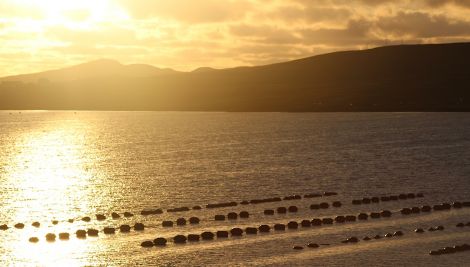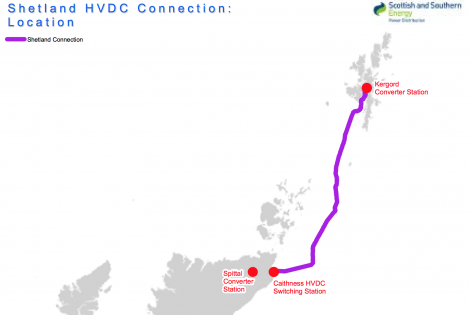Energy / Mussel farmers concerned over subsea cable plans
There are six active mussel farms in Weisdale Voe, where the cable would run in to from Caithness
MUSSEL farmers operating in Weisdale Voe have strongly objected to plans for the proposed transmission cable which would run through their production area, saying it would have a “major impact” on their businesses.
Blueshell Mussels, Shetland Mussels and Zetland Mussels – as well as industry body Seafood Shetland – have all lodged objections to a works licence application for the 600MW cable proposed by SSE’s transmission arm.
There is a preference from the industry for the energy company to instead explore alternative landfall sites where there is less aquaculture present, such as west of Weisdale Voe at Sandsound.
As it stands the 250 km long cable would run from Caithness to Weisdale, with a 200m corridor in the voe as a works area. From there the cable would be placed underground before heading north to a converter station at Upper Kergord.
The HVDC cable would allow proposed large wind farms like Viking Energy to export energy, while it would also offer power to be sent north – providing a way for Shetland’s demands to be met when Lerwick Power Station closes before 2026.
In late April energy regulator Ofgem said it was minded to approve the cable if there was sufficient evidence that the proposed 103-turbine Viking Energy wind farm would go ahead.
But with six active mussel farms in Weisdale Voe, and four salmon farms in the nearby area, concerns over the cable plans have been raised by the aquaculture industry.
Around 80 per cent of Scotland’s mussel production is being farmed in Shetland waters.
Seafood Shetland chief executive Ruth Henderson said in a letter to Shetland Islands Council’s planning service that the area is “significantly important” for growing mussels, with many full-time jobs reliant on the output.
There is also a frustration that the application has been submitted during the lockdown phase of the Covid-19 response.
Become a member of Shetland News
“A significant percentage of the populace is working from home and given the potentially major impacts which the cable installation imposes on the wider seafood sector and others, it is important that all issues and concerns are able to be fully deliberated by those likely to be affected, submitted, acknowledged and acted upon,” Henderson wrote.
Blueshell Mussels managing director Michael Laurenson said in his objection that the plans would have a major impact on its three existing farms in the area – sites that have been in place for up to 17 years.
They are said to be important collection areas for spats – young mussels – with spat production “critical to the success” of the business.
Laurenson wrote that if these three sites are reduced or removed it will “seriously impact the overall tonnage”, potentially leading to the loss of jobs.
The proposed ‘corridor’ of the cable is only 30 metres away from one of the sites.
The company was previously informed that proximity agreements would be in place before any application was made, but “this never happened”, Laurenson said in his letter to planners.
It is also claimed that the developer has not followed the process of the European Subsea Cable Association, which recommends that consultation be carried out with other developments within 750 metres, and no less than 250m.
Laurenson also raised in his objection concerns over a potential 500m zone needed around cable ships, which mussel farms would fall into.
“The fact SSE have not consulted us, or not even tried to contact us prior to applying for the cable, demonstrates they have little consideration for existing operators,” he wrote.
Shetland Mussels director Richard Tait, meanwhile, wrote in an objection that the company operates two farm sites in Weisdale Voe.
He said the proposed location of the cable is too close to Shetland Mussels’ sites – potentially around 180m from both.
Tait also told the planning service that any sediment which could potentially end up suspended in the water during the laying process could be digested by mussels, and with the company’s products sold as “grit-free”, they would not be sellable.
He also raised concern over the possible safety impact on employees.
Walls-based Zetland Mussels, which operates one farm in Weisdale Voe, has also objected.
Managing director Michael Tait also raised in his objection concern over sediment, saying that a loss of stock due to sediments present would be “ruinous” to the company.
“For the environmental appraisal to judge this as unlikely to happen and that the sediment is expected to disperse is not satisfactory and has not been appraised as being of enough importance,” he wrote.
Zetland Mussels also wants further details on exclusion zones around vessels used during the installation so that it could fulfil its weekly sampling requirements for Food Standards Scotland.
Seafood Shetland’s Ruth Henderson, meanwhile, said the organisation has no definitive view on large-scale wind farms and, as a result, the viability of a HVDC cable.
“However, irrespective of viewpoint, no business would stand on the sidelines while its livelihood faced potential detrimental impact by any element of the overall wider picture, this one in particular,” she wrote.
Seafood Shetland represents the interests of every local shellfish growing company, with Henderson echoing their concerns in her objection.
Campaign group Sustainable Shetland, which is opposed to large wind farm developments in the isles, has already objected to the application, as have some members of the public.
SSEN Transmission previously said that “as well as unlocking Shetland’s renewable potential, the link would help address Shetland’s security of supply needs as well as offering Shetland’s oil and gas sector a unique opportunity to decarbonise its operational electricity requirements, delivering a whole system approach to support the transition to net zero emissions”.
A SSEN Transmission spokesperson said: “We continue to work with all stakeholders, welcoming their feedback, as our marine works licence application progresses through the statutory process.”
Become a member of Shetland News
Shetland News is asking its many readers to consider paying for membership to get additional features and services: -
- Remove non-local ads;
- Bookmark posts to read later;
- Exclusive curated weekly newsletter;
- Hide membership messages;
- Comments open for discussion.
If you appreciate what we do and feel strongly about impartial local journalism, then please become a member of Shetland News by either making a single payment, or setting up a monthly, quarterly or yearly subscription.








































































